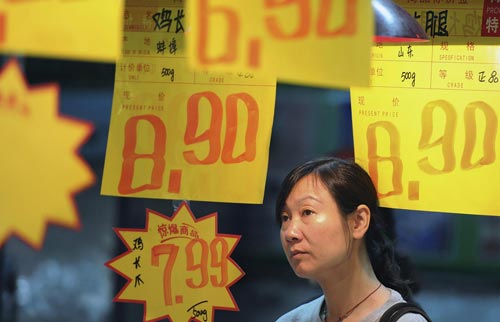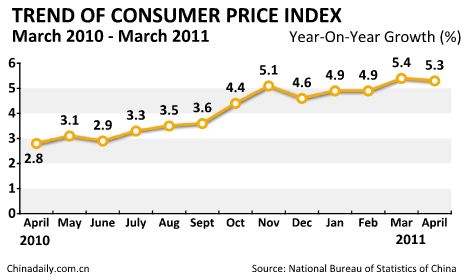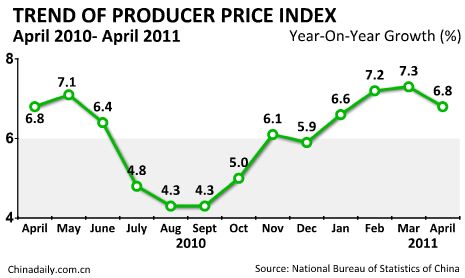Statistics
China's April CPI up 5.3%, PPI up 6.8%
(Xinhua)
Updated: 2011-05-11 10:14
 |
Large Medium Small |
 |
|
A customer looks at price tags in a supermarket in Hefei, Anhui province May 11, 2011. China's headline consumer price inflation slowed to 5.3 percent in the year to April from 5.4 percent in March, the National Bureau of Statistics (NBS) said on May 11, 2011. [Photo/Agencies] |
BEIJING -- China's consumer price index (CPI), a main gauge of inflation, rose 5.3 percent in April from a year ago, the National Bureau of Statistics (NBS) said on Wednesday.
The April figure was down 0.1 percentage points from March's 32-month high of 5.4 percent, according to the NBS.
"Price rises have been held in check, indicating that the country's price control measures have achieved preliminary results," said NBS spokesman Sheng Laiyun.
Food prices, which account for nearly a third of the basket of goods in the nation's CPI calculation, surged 11.5 percent year-on-year. Non-food prices rose 2.7 percent from a year earlier.
| ||||
The producer price index, a main gauge of inflation at the wholesale level, rose 6.8 percent in April from a year ago, down 0.5 percentage points from the previous month.
Sheng attributed the smaller PPI increase to last April's high base and fluctuating commodity prices in the global market.
Last month, consumer prices rose 5.2 percent in urban areas and 5.8 percent in rural regions, compared with a year earlier. The April CPI is above the government's target of 4 percent for the year.
There remain uncertainties in curbing inflation but prices will be kept stable as long as local authorities strictly carry out the central government's policies, said the NBS spokesman.
Government measures to contain vegetable prices are having an effect, said Wang Xiaoguang, a research fellow at the Policy Advisory Department of the Chinese Academy of Governance, adding that he expected CPI to drop slightly in the second quarter from the first quarter's 5 percent growth.
China's quarterly inflation downward trend would continue, said Wang, forecasting a lower than 4 percent quarterly CPI growth rate in the third quarter and less than 3 percent growth in the forth.
During the week of May 2 to 8, the average wholesale prices of 18 types of vegetables dropped 3.1 percent from the previous week, China's commerce ministry said in a statement on its website Tuesday. The decline was 1.1 percentage points lower than that of the previous week.
"Imported inflation eased last month but there is still abundant liquidity in the domestic market. The authorities will take the GDP growth into consideration before further tightening moves," said Zhuang Jian, senior economist with the Asian Development Bank.
If GDP continues to grow at between 8 and 9 percent, there will be more tightening measures, Zhuang added.
The People's Bank of China, the central bank, announced the second interest rate hike this year on April 5.
The one-year deposit interest rate has climbed to 3.25 percent while the one-year loan interest rate presently stands at 6.31 percent.
To mop up the excessive liquidity, China's central bank has raised the reserve requirement ratio for commercial banks four times since the beginning of this year.
China's new bank lending, an important indicator of monetary policy, stood at 739.6 billion yuan ($113.8 billion) in April, a decrease of 20.8 billion yuan from a year earlier, the People's Bank of China said on Wednesday.
The broad money supply, which covers cash in circulation and all deposits, increased 16.6 percent year-on-year as of the end of March, 0.9 percentage points higher than that as of the end of February. The increase exceeded the government's target ceiling of 16 percent for 2011 set in a government work report released in March.
Wang played down the direct impact of increasing money supply on CPI growth, claiming that inflation would have already hit double digits if it had a direct link with the money supply.
"There could be another reserve requirement ratio hike in May. The slower industrial expansion does not necessarily mean the economy will slow down. The tightening trend will continue for a while," said Lu Zhengwei, chief economist with Industrial Bank Co Ltd.
China's industrial value-added output rose 13.4 percent year-on-year in April, down from March's 14.8-percent growth, the NBS said Wednesday.


| 分享按钮 |



